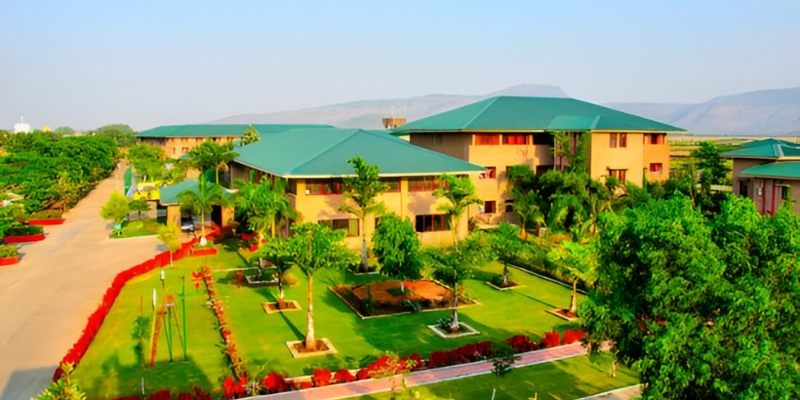

Cathedral Vidya School
Opposite Mumbai Pune Highway, Shilatne, Village, National Highway 4 Pune, Maharastra, India
⭐ True 11+ Ratings
Co-ed
IB
Maharastra


⭐ True 11+ Ratings
Co-ed
IB
Maharastra
Prepare for Cathedral Vidya School Entrance exam with True11 Plus
82.9% Selection rate in last 5 years
45+ selections in last 2 years
Crack exam in 1st attempt
150+ Recorded videos | 2000+ Exercise Questions | 4000+ Practice questions | 15 Objective +10 Subjective Mock test

Located in the lush Sahyadri Hills, The Cathedral Vidya School in Lonavala was famous for its holistic international education until it was withdrawn in May 2022 for financial reasons. The school opened in 2008 as the residential extension of Cathedral and John Connon School in Mumbai (1850), continuing a 150-year tradition of academic excellence and character formation.
It was a day-cum-residential, co-educational school with an English-medium of instruction for grades 4 to 12. The school offered the British National Curriculum for middle school, IGCSE for grades 9 and 10, and IBDP for grades 11 and 12.
On a 40-acre campus in pollution-free Shilatane village, Karla on the Mumbai-Pune Highway, the school was able to accommodate up to 450 students with a low maximum teacher-student ratio of 1:12 ensuring a community that was inclusive and embraced diversity regardless of ability, culture, or nationality.
The motto of the school in Latin, “Clarum Efficiunt Studia” (Studies Maketh Famous) stressed the importance of discipline, hard work, and simplicity, which had been inherited from the Mumbai school under the management of the Anglo-Scottish Education Society. The school graduated eight batches in 14 years sending students to selected global universities, including Ivy League Universities and IITs, and scholarships.
Although it is no longer operating, the Cathedral Vidya School has a legacy through its former students and the impact it had on residential education throughout India. The School itself is located just two hours from Mumbai and one hour from Pune, and offered a calming, balanced learning experience in nature for urban families.
The Cathedral Vidya School was a developmental journey of transforming young children into articulate, compassionate, and rational thinkers who identified as both Indian and Global citizens. Extending the legacy of the Cathedral and John Connon School, opened in 2008 to provide informational students a residential alternative to combine the urban and hill-station value of rigorous academics.
The parent school, which has been a pioneer since 1860, produced great people and achievers, including Field Marshal Sam Manekshaw and Oscar-winner Resul Pookutty. Vidya School simply carried that tradition into a new context.
The school’s goal was to develop excellence through (+) six domains of development: academic, physical, emotional, spiritual, social, and environmental. Under the leadership of Principal, Mr. Pourushasp F. Karkaria, the School built the value of passionate and multidimensional faculty who acted as mentors facilitating a hands-on and collaborative educational environment, regardless of the context.
For example, while learning was done in multiple cultural environments, the school’s ethos promoted inclusivity to respect and honour the various religious practices of each student; in practice, students were provided special meals for Ramadan and Navrati and also given private opportunities to pray and honour their spiritual practices.
Each student in grades 6 and higher were provided computers which included supervision of internet use as part of the curriculum, in addition to other strategy use of each student’s technology experience as citizens. Parental involvement was at a high level, with weekly check-in calls, Sunday visits, and mentorship programs helping to bridge the boundaries between home and campus. Even after the school was closed down, and with its full model being adopted by several regional schools, it has demonstrated that residential education can effectively balance tradition and change.
The school’s infrastructure was a unique blend of functional utility and aesthetic harmony, providing the goals of learning opportunities in a vibrant, fluid educational ecosystem.
• Academic Facilities: Large, bright and well-ventilated, indoor classrooms that included interactive whiteboards, projector screen, and ergonomic flex desks for shared seating arrangements.
• Science and Technology: A variety of modern science labs for physics, chemistry and biology and a computer center providing coding fun from early grades.
• Library: Over 10,000 volumes, archives for digital research, and e-resources to support student inquiry and reflection.
• Residential Blocks: Air-conditioned student accommodation for 450 students in a shared 4-bedroom design including a study desk, wardrobe and ensuite bathrooms, assisted by a parent figure for every 20 students.
• Dining Hall: The dining hall is designed like a cafeteria, with vegetarian, non-vegetarian, and Jain meal options available all made from fresh, local ingredients.
• Eco-Initiatives: Solar panels, rainwater harvesting, and ongoing green upgrades.
• Security: 24/7 CCTV, gated access, and trained staff to ensure safety.
• Administrative Wing: Conference rooms, and cleaning facilities for the personal hygiene of students.
This facility created a model for residential schools standardising a high level of safety, sustainability and comfort for children, and even influenced designs after our closure in Maharashtra.
The 40-acre site in Shilatane village, Karla, set amongst the fertile Sahyadri Hills, was a haven of nature and learning. The campus was located on the Mumbai-Pune Highway, 15 minutes from Lonavala, an hour from Pune and two hours from Mumbai, making it both easily accessible and tranquil.
• Layout: The academic buildings were central and were flanked by green lawns and a rose garden that acted as an outdoor classroom.
• Recreational Areas: Sports fields, an amphitheater for assemblies, and a science park that provided astronomy and ecology experiences.
• Residential Zones: The boys’ and girls’ blocks were located at the edge of the campus, providing views of the hill and privacy for the children.
• Eco Features: Water bodies, a pond for environmental studies, and composting units provided hands-on experience of sustainability.
• Setting: Clean air, native trees, and solar-lit pathways provided a peaceful atmosphere conducive to community building and connection with nature.
Lessig encouraged students to explore the forest and take part in activities that brought them into direct contact with nature, helping them develop resilience and appreciation of biodiversity as a result. The discussions continue after the closure of the campus about what to do with these physical spaces that houses educational trusts.
Cathedral Vidya School had world-class facilities that catered to growth on all levels.
• Health Center: 24 hour a day facility, with services of a doctor, nurse, ambulance, and hospital partnerships within 30 minutes.
• Sports: Fields for football and cricket with floodlights; courts for basketball and tennis, swimming pool, and indoor halls for badminton and table tennis.
• Arts: Studios for painting, pottery, music (pianos and percussion) and a theatre for drama.
• Library/Media: Global subscriptions to journals and a media center for research.
• Cafeteria: Balanced menus made by a dietitian.
• Technology: Robotics lab, astronomy observatory to track celestial objects and events.
• Accessibility: Ramps and sensory gardens for various needs.
These facilities created a self-contained world with opportunities for learning outside of academics, creating a lasting blueprint.
Admission was competitive, given the ethos of the school and the characteristics of the academic experience.
• Online Inquiry: Level of inquiry form via www.cathedral-lonavala.org with a non-refundable deposit.
• Assessment: Play (lower grades), written tests and/or interviews (middle school), subject-based assessments (IGCSE/IBDP).
• Campus Tour: An orientation for parents to gain insight into the residential experience.
• Selection: All selection is based on merit, and will give priority to siblings and families who attend Cathedral in Mumbai.
• Confirmation: Confirmations are sent via email, and an offer is considered binding when an initial payment has been made promptly.
• Grade 4 to 8: must complete Grade 3, proficient in English and 9-10 years old for Grade 4.
• Grade 9-10 (IGCSE): Must have equivalent qualifications and be assessed academically.
• Grade 11-12 (IBDP): Must have an aggregate mark of 80% or greater with an interview to discuss fit for residency.
• General: Encouragement of diversity with accommodation for international students.
Birth Certificate
• Former academic records and transfer certificate
• Recent passport-size picture of child and parents
• Parent identifications (Aadhaar/Passport)
• Physical health certificate
• Proof of residence
• Vaccination card/s and character reference letters (for Duke of Edinburgh boarders)
The fee captured the premium residential-international model, encompassing tuition, boarding, and co-curricular (beyond-the-classroom) programs.
• Breakdown: Tuition (50%), boarding/meals (30%), and use of facilities (20%)
• Payment: Instalments, annually assessed
• Merit-based: up to 20-50% tuition concession for academic excellence, sporting excellence, or arts excellence, based on entrance tests.
• Need-based: for talented, underprivileged students, scholarship for access to the school.
The core of the education was in sports, which offered more than 30 disciplines, including the Spandan annual inter-school tournament for regional schools.
• Facilities: Cricket and football fields are floodlit, as well a basketball court, tennis courts, swimming pool and indoor badminton and table tennis.
• Events: Inter-house cups and participation in district and national sporting events.
• Health & Wellbeing: Yoga, and Sahyadri treks, both of which built fitness and mindfulness.
These activities built team spirit, and resilience, and aligned with the school’s vision of holistic education.
The extracurricular learning sparked children’s creativity and leadership.
• Clubs: Debate team CIMUN, robotics club, literary, festivals, and astronomy club.
• Weekend Activities: Chess, gardening, and work with the Students’ Council
• Events: Dusty harts annual play, art displays, community volunteering.
The increasing participation in extracurricular initiatives has allowed for growth in a diverse environment that inspires safe risk-taking.
Eight cohorts of alumni are active worldwide, many studying at Harvard, Oxford, IITs, and IIMs.
• Accomplishments: They are entrepreneurs, scientists and artists contributing to communities across the planet.
• Community: There are active alumni groups that help to facilitate mentorship and placement, continue the school’s spirit of community and engagement.
Cathedral Vidya School closed in 2022 due to financial issues, but its legacy as a developer of global minds lives on. The holistic model from CVFS, the probation of learning, the inclusion of nature and diversity of perspectives, continues to inspire meaningful change in both education and the application of learning, that is, that learning can happen anywhere, and it often “travels” with us in a way that transcends space and environment.
The Cathedral and John Connon School has an approximate annual fee of INR 8,70,000, which consists of an admission fee of INR 62,000 and a security deposit fee of INR 50,000. The annual fees vary according to the curriculum as well. The CISCE curriculum is approximately INR 1.2 lakh annually, while the IBDP program is around INR 6.7 lakh annually.
The school offers the British National Curriculum for Grades 4-8, IGCSE for Grades 9-10, and the International Baccalaureate Diploma Programme (IBDP) for Grades 11-12, integrating international standards with Indian values, in keeping with being a Plymouth College in the UK.
The 40-acre campus offers air-conditioned residential blocks, floodlit sports fields for cricket and football, basketball and tennis courts, a swimming pool, science labs, a library with over 10,000 books, art studios, a health center, and eco-friendly aspects such as solar panels.
Extracurricular activities included CIMUN debates, robotics clubs, literary festivals, astronomy sessions, inter-house sports tournaments, yoga, treks, chess, gardening, drama, music, and community service through the Students’ Council.
The school has a dynamic alumni community across eight graduated cohorts, with alumni studying at some of the best universities in the world like Harvard, Oxford, IITs and IIMs, and engaging with the school through a mentorship program and their professional contributions around the world.


Get in touch with our Edu Experts
No worries. We're here to help you at
every stage of your entrance preparation.